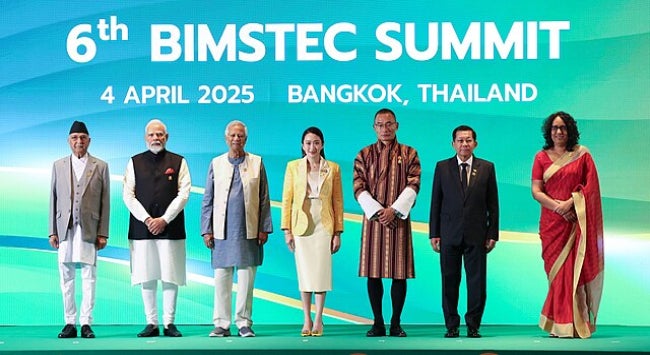Summary
As a regional organisation, the Multi-Sectoral Technical and Economic Cooperation serves as a crucial bridge between South and Southeast Asia and holds significant potential for regional integration. However, it continues to face several challenges that hinder its ability to function as a cohesive and effective bloc.
On 4 April 2025, the sixth Summit of the heads of states/governments of the member states of the Bay of Bengal Initiative for Multi-Sectoral Technical and Economic Cooperation (BIMSTEC) took place in Bangkok, Thailand. It was the first in-person meeting of the leaders in seven years. The Summit was originally scheduled to be held in Bangkok in 2023 but was postponed by Thailand. Last year, the Thai government again postponed the Summit. At that point in time, the Thai court dismissed Srettha Thavisin as prime minister, and his successor, Paetongtarn Shinawatra, had yet to name her cabinet.
BIMSTEC comprises Bangladesh, Bhutan, India, Myanmar, Nepal, Sri Lanka and Thailand. It was established with the signing of the Bangkok Declaration on 6 June 1997 and was originally called Bangladesh-India-Sri Lanka-Thailand Economic Cooperation. Myanmar was admitted to the organisation on 22 December 1997, and Bhutan and Nepal join it in February 2004. A permanent BIMSTEC Secretariat in Dhaka, Bangladesh, was inaugurated on 13 September 2014. On 30 March 2022, during the fifth Summit in Colombo, the BIMSTEC Charter was signed and adopted.
Notwithstanding its slow progress, BIMSTEC has huge economic potential. It brings together 1.67 billion people and a gross domestic product of around US$3.71 trillion (S$4.9 trillion). Having said that, intra-BIMSTEC trade in 2023 was a mere 6.7 per cent. To increase intra- BIMSTEC trade, Paetongtarn proposed accelerating the establishment of the BIMSTEC Free Trade Agreement.
In Thailand, Bangkok 2030 was adopted. The BIMSTEC member states also signed the Maritime Transport Cooperation to strengthen regional partnerships, enhance maritime connectivity and enable more trade and travel. Thailand’s Land Bridge project connecting the Gulf of Thailand with the Bay of Bengal (Andaman Sea) and the Thailand-India- Myanmar international highways are important connectivity projects. BIMSTEC signed a memorandum of understanding with the Indian Ocean Rim Association and the United Nations Office on Drugs and Crime. The member states also adopted the Rules of Procedure for the BIMSTEC Mechanisms and the Report of Eminent Persons Group on the Future Direction of BIMSTEC. The leaders underlined the need to make progress in enhancing intra-regional trade and investment, connectivity, tourism, culture exchanges, climate action, green and renewable energy, sustainable agriculture, food security, disaster management and security. The Bangkok Summit also endorsed the Joint Statement on the impact of the earthquake which struck Myanmar and Thailand in March 2025. Besides expressing condolences, solidarity and commitment to support affected countries, it reaffirmed a commitment to collaborate in regional disaster management and strengthen response mechanisms for natural disasters.
The various agreements and initiatives point to the strong potential of growth for BIMSTEC. However, despite promise, BIMSTEC faces some serious challenges. First, it has moved disappointingly slowly, which alludes to developments in the politically volatile region influencing the organisation’s work and meetings. Second, any regional organisation’s success largely depends on good ties or minimal political differences, tensions and disputes among the member states. Article 19 of the BIMSTEC Charter states that “…member states shall endeavour to resolve peacefully all disputes in a timely manner through dialogue, consultation and negotiation”. Still, tensions exist between the member states over several issues. For instance, the Rohingya issue remains a thorn in the relations between Myanmar and Bangladesh. In April 2025, Myanmar confirmed that it had identified 180,000 Rohingyas out of a list of 800,000 Rohingya refugees living in Bangladesh eligible to return home. The list was provided to Myanmar by Bangladesh in six batches during 2018-20. However, the final verification of another 70,000 Rohingyas is pending. BIMSTEC is unable to do much on the internal matters of the member states, as any country will take that as an interference in sovereign matters. Third, political events in a member country, such as the military coup in Myanmar in 2021, followed by war between the state and ethnic groups, hinder BIMTEC’s goal to accelerate economic growth and social progress and promote peace, prosperity and sustainability in the Bay of Bengal region. Internal political events also put some pressure on BIMSTEC. For example, an invitation to Myanmar’s Junta leader Min Aung Hlaing to the BIMSTEC Summit in Bangkok drew criticism. Outside the Bangkok hotel where he held talks with BIMSTEC leaders, protestors hung a banner reading “We do not welcome murderer Min Aung Hlaing”.
The BIMSTEC member states could begin addressing some of their shared challenges through closer cooperation and collective action. A recent example highlighting the need for such unity was the imposition of reciprocal tariffs by United States President Donald Trump on the country’s trading partners. Within BIMSTEC, these tariffs varied significantly – 26 per cent on India, 36 per cent on Thailand, 37 per cent on Bangladesh, 44 per cent on both Sri Lanka and Myanmar, and 10 per cent on Nepal and Bhutan. As a first step, BIMSTEC could consider formulating a coordinated response to such external economic pressures. More importantly, these tariffs could serve as a catalyst for deeper regional integration, encouraging the member states to strengthen the organisation and enhance intra-regional cooperation. Whether BIMSTEC can seize this opportunity and rise to the challenge, however, remains to be seen.
. . . . .
Dr Amit Ranjan is a Research Fellow at the Institute of South Asian Studies (ISAS), an autonomous research institute at the National University of Singapore (NUS). He can be contacted at isasar@nus.edu.sg. The author bears full responsibility for the facts cited and opinions expressed in this paper.
Image: Wikimedia Commons
-
 More From :
More From :
-
 Tags :
Tags :
-
 Download PDF
Download PDF



